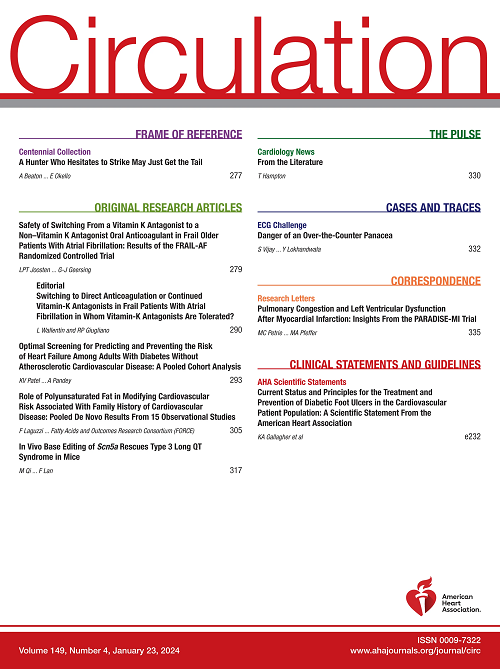Subclinical Primary Aldosteronism and Major Adverse Cardiovascular Events: A Longitudinal Population-Based Cohort Study.
IF 35.5
1区 医学
Q1 CARDIAC & CARDIOVASCULAR SYSTEMS
引用次数: 0
Abstract
BACKGROUND Primary aldosteronism (PA), an overt form of renin-independent aldosterone production, leads to a disproportionately high rate of major adverse cardiovascular events (MACEs). Mounting evidence suggests that milder forms of renin-independent aldosterone production (subclinical PA) are highly prevalent; however, the link between subclinical PA and MACE remains uncertain. METHODS This prospective study included 2017 Canadian adults 40 to 69 years of age from the randomly sampled, population-based CARTaGENE cohort (Québec, Canada), in which aldosterone and renin concentrations at enrollment (2009-2010) were measured. Follow-up data were obtained via provincial health care administrative database linkage. MACE outcomes consisted of a composite of myocardial infarction, stroke, hospitalization for heart failure, and cardiovascular death. Multivariable linear and nonlinear Cox regression models measured the associations of concentrations of aldosterone, renin, and the aldosterone-to-renin ratio with MACE. Outcome-derived optimal thresholds for these markers were then determined. RESULTS The mean (SD) age of participants was 56 (8) years, and 45% were women. Mean blood pressure was 129 (15)/76 (10) mm Hg, with hypertension being present in 27%. Over a median follow-up time of 10.8 years, 57 (3%) MACE outcomes occurred. Lower renin concentration (adjusted hazard ratio [aHR], 2.22 [95% CI, 1.02-4.76]) and higher aldosterone-to-renin ratio (aHR, 2.43 [95% CI, 1.15-5.12]) were associated with a higher risk for MACE, whereas no significant association was found with aldosterone concentration (aHR, 1.57 [95% CI, 0.42-5.90]). Renin concentration exhibited a nonlinear relationship with MACE risk. The outcome-derived optimal thresholds to discriminate a higher MACE risk were renin concentration ≤4.0 ng/L (aHR, 2.12 [95% CI, 1.21-3.72]) and aldosterone-to-renin ratio ≥70 pmol/L per ng/L (aHR, 2.03 [95% CI, 1.09-3.80]). All aforementioned associations were independent of blood pressure. CONCLUSIONS Independent of blood pressure, the subclinical PA biochemical phenotype is associated with an increased risk of MACE. Future studies are necessary to determine whether early identification and targeted treatment of subclinical PA mitigates this risk.亚临床原发性醛固酮增多症和主要不良心血管事件:一项纵向人群队列研究。
背景:原发性醛固酮增多症(PA)是肾素不依赖型醛固酮产生的一种显性形式,可导致不成比例的主要不良心血管事件(mace)发生率。越来越多的证据表明,轻度肾素非依赖性醛固酮产生(亚临床PA)非常普遍;然而,亚临床PA和MACE之间的联系仍不确定。方法本前瞻性研究纳入了2017名年龄在40至69岁之间的加拿大成年人,他们来自随机抽样的以人群为基础的CARTaGENE队列(quacimbec, Canada),测量了入组时(2009-2010年)醛固酮和肾素浓度。随访数据通过省级卫生保健管理数据库链接获得。MACE结果包括心肌梗死、中风、心力衰竭住院和心血管死亡。多变量线性和非线性Cox回归模型测量了醛固酮、肾素浓度以及醛固酮与肾素之比与MACE的关系。然后确定这些标记的结果衍生的最佳阈值。结果参与者的平均(SD)年龄为56(8)岁,其中45%为女性。平均血压为129 (15)/76 (10)mm Hg,高血压发生率为27%。在10.8年的中位随访时间中,发生了57例(3%)MACE结果。较低的肾素浓度(校正危险比[aHR], 2.22 [95% CI, 1.02-4.76])和较高的醛固酮-肾素比(aHR, 2.43 [95% CI, 1.15-5.12])与MACE的高风险相关,而醛固酮浓度(aHR, 1.57 [95% CI, 0.42-5.90])与MACE的风险无显著相关性。肾素浓度与MACE风险呈非线性关系。鉴别较高MACE风险的最佳阈值为肾素浓度≤4.0 ng/L (aHR, 2.12 [95% CI, 1.21-3.72])和醛固酮与肾素比值≥70 pmol/L / ng/L (aHR, 2.03 [95% CI, 1.09-3.80])。上述所有关联都与血压无关。结论与血压无关,亚临床PA生化表型与MACE风险增加相关。未来的研究需要确定早期识别和靶向治疗亚临床PA是否可以减轻这种风险。
本文章由计算机程序翻译,如有差异,请以英文原文为准。
求助全文
约1分钟内获得全文
求助全文
来源期刊

Circulation
医学-外周血管病
CiteScore
45.70
自引率
2.10%
发文量
1473
审稿时长
2 months
期刊介绍:
Circulation is a platform that publishes a diverse range of content related to cardiovascular health and disease. This includes original research manuscripts, review articles, and other contributions spanning observational studies, clinical trials, epidemiology, health services, outcomes studies, and advancements in basic and translational research. The journal serves as a vital resource for professionals and researchers in the field of cardiovascular health, providing a comprehensive platform for disseminating knowledge and fostering advancements in the understanding and management of cardiovascular issues.
 求助内容:
求助内容: 应助结果提醒方式:
应助结果提醒方式:


